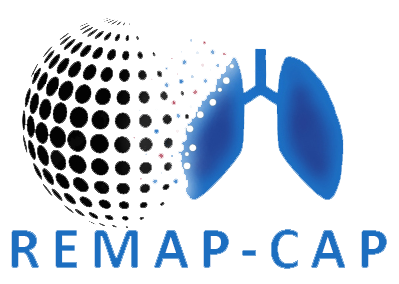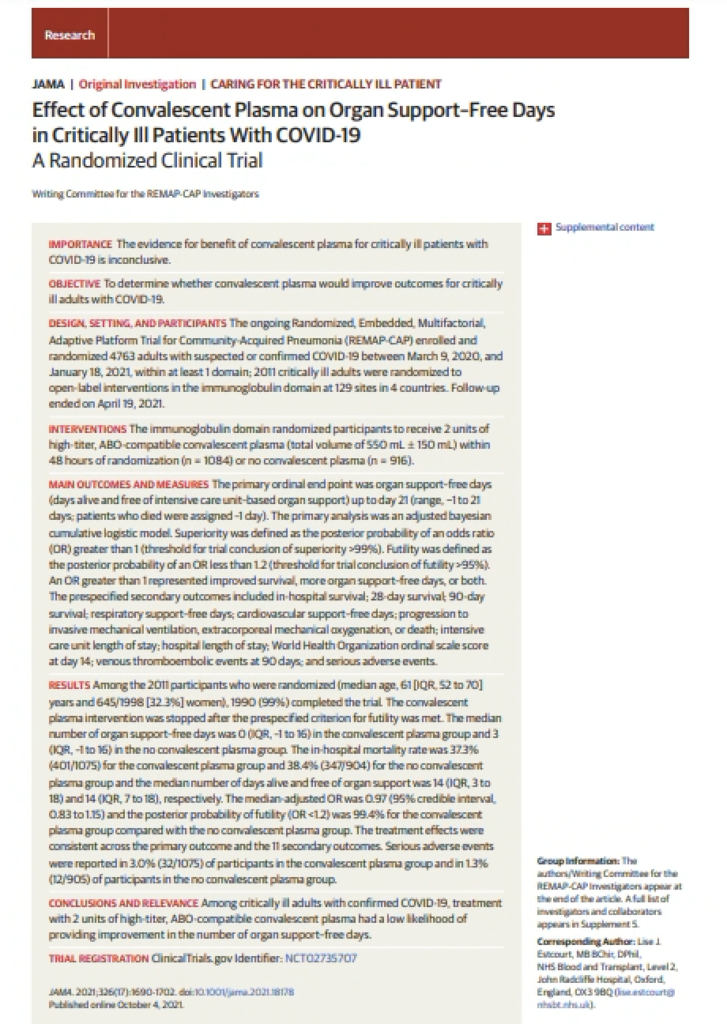Importance
The evidence for benefit of convalescent plasma for critically ill patients with COVID-19 is inconclusive.
Objective
To determine whether convalescent plasma would improve outcomes for critically ill adults with COVID-19.
Design, Setting, and Participants
The ongoing Randomized, Embedded, Multifactorial, Adaptive Platform Trial for Community-Acquired Pneumonia (REMAP-CAP) enrolled and randomized 4763 adults with suspected or confirmed COVID-19 between March 9, 2020, and January 18, 2021, within at least 1 domain; 2011 critically ill adults were randomized to open-label interventions in the immunoglobulin domain at 129 sites in 4 countries. Follow-up ended on April 19, 2021.
Interventions
The immunoglobulin domain randomized participants to receive 2 units of high-titer, ABO-compatible convalescent plasma (total volume of 550 mL ± 150 mL) within 48 hours of randomization (n = 1084) or no convalescent plasma (n = 916).
Main Outcomes and Measures
The primary ordinal end point was organ support–free days (days alive and free of intensive care unit–based organ support) up to day 21 (range, −1 to 21 days; patients who died were assigned –1 day). The primary analysis was an adjusted bayesian cumulative logistic model. Superiority was defined as the posterior probability of an odds ratio (OR) greater than 1 (threshold for trial conclusion of superiority >99%). Futility was defined as the posterior probability of an OR less than 1.2 (threshold for trial conclusion of futility >95%). An OR greater than 1 represented improved survival, more organ support–free days, or both. The prespecified secondary outcomes included in-hospital survival; 28-day survival; 90-day survival; respiratory support–free days; cardiovascular support–free days; progression to invasive mechanical ventilation, extracorporeal mechanical oxygenation, or death; intensive care unit length of stay; hospital length of stay; World Health Organization ordinal scale score at day 14; venous thromboembolic events at 90 days; and serious adverse events.
Results
Among the 2011 participants who were randomized (median age, 61 [IQR, 52 to 70] years and 645/1998 [32.3%] women), 1990 (99%) completed the trial. The convalescent plasma intervention was stopped after the prespecified criterion for futility was met. The median number of organ support–free days was 0 (IQR, –1 to 16) in the convalescent plasma group and 3 (IQR, –1 to 16) in the no convalescent plasma group. The in-hospital mortality rate was 37.3% (401/1075) for the convalescent plasma group and 38.4% (347/904) for the no convalescent plasma group and the median number of days alive and free of organ support was 14 (IQR, 3 to 18) and 14 (IQR, 7 to 18), respectively. The median-adjusted OR was 0.97 (95% credible interval, 0.83 to 1.15) and the posterior probability of futility (OR <1.2) was 99.4% for the convalescent plasma group compared with the no convalescent plasma group. The treatment effects were consistent across the primary outcome and the 11 secondary outcomes. Serious adverse events were reported in 3.0% (32/1075) of participants in the convalescent plasma group and in 1.3% (12/905) of participants in the no convalescent plasma group.
Conclusions and Relevance
Among critically ill adults with confirmed COVID-19, treatment with 2 units of high-titer, ABO-compatible convalescent plasma had a low likelihood of providing improvement in the number of organ support–free days.







